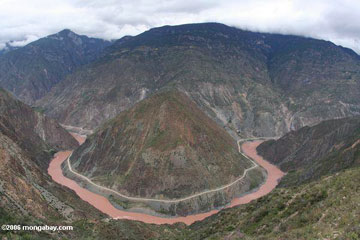- In December of 2006 it was announced that the Yangtze River dolphin, commonly known as the baiji, had succumbed to extinction.
- The dolphin had survived on earth for 20 million years, but the species couldn’t survive the combined onslaught of pollution, habitat loss, boat traffic, entanglement in fishing hooks, death from illegal electric fishing, and the construction of several massive dams.
- Now, another flagship species of the Yangtze River appears to have vanished.
In December of 2006 it was announced that the Yangtze River dolphin, commonly known as the baiji, had succumbed to extinction. The dolphin had survived on earth for 20 million years, but the species couldn’t survive the combined onslaught of pollution, habitat loss, boat traffic, entanglement in fishing hooks, death from illegal electric fishing, and the construction of several massive dams. Now, another flagship species of the Yangtze River appears to have vanished.
As reported by the BBC last month, a three year quest to find the Chinese paddlefish has revealed not one sighting. The story is remarkably similar to that of December 2006 when a six week expedition failed to find any sign of the baiji.
Reaching a staggering seven meters, the Chinese paddlefish is one of the largest freshwater fish in the world. So little is known about the species that biologists aren’t even certain it can properly be referred to as ‘freshwater’, since the fish may cross between the freshwaters of the Yangtze River to oceanic environments. But no one knows for sure.
 The muddy upper Yangtze in northwestern Yunnan. Photo by: Rhett A. Butler. |
The expedition to find the Chinese paddlefish deployed over 4000 setline and over 900 nets, but couldn’t find a single giant fish, which has been classified by the IUCN Red List as Critically Endangered for over a decade. Despite their inability to locate the Chinese paddlefish, expedition leaders like Professor Wei Qiwei, believe there is still a good chance that some survive.
“The individuals born in the late 1980s and early 1990s should survive in the wild, since the Yangtze river system is large and it has some complicated habitats where the paddlefish could hide,” Qiwei told the BBC.
If fish do survive, however, Qiwei says that they will need active aid from people to avoid extinction, including modern technology to make reproduction possible in such a small, probably fragmented, population. Of course, first the fish have to be found.
The same factors that devastated the baiji are behind the Chinese paddlefish decline and possible extinction: habitat degradation, overfishing, pollution, and massive dam building.
 The Yangtze when it reaches Shanghai. Photo by: Rhett A. Butler. |
In 2007 a report by China’s official State Environmental Protection Administration (SEPA) found that 30 percent of the Yangtze river’s tributaries are “seriously polluted” while 600 kilometers of the river’s water is in “critical condition”. According to the report the river’s annual harvest of fish from the river has dropped 77 percent from the 1950s to the 1990s.
Despite the environmental crisis facing Asia’s longest river, Chinese officials are currently considering building another Yangtze River dam. Entitled the Xiaonanhai Dam, its construction would affect the river’s only fish reserve and one of the last places where the Chinese paddlefish may survive. In June of this year several environmentalists spoke out saying that the dam could lead to the extinction of even more endangered species, including the Chinese paddlefish.
At the time David Dudgeon, professor of freshwater ecology at the University of Hong Kong, told Reuters: “My guess is that the paddlefish and the Yangtze sturgeon are on the way to extinction already but there are other species that the reserve may be critically important for. The (Xiaonanhai) dam would probably finish off some of the more vulnerable species — the last nail in the coffin.”
With perhaps two flagship species vanishing in a single decade, the Yangtze River is becoming a hotspot for extinction. But it doesn’t look as though it will end there: the Chinese sturgeon and the finless porpoise, both suffering from the same impacts as the baiji and Chinese paddlefish, look like probable candidates for the next extinction announcement.
The Yangtze River is also home to the Critically Endangered Chinese alligator, one of the world’s most threatened crocodilians.
Related articles
New Yangtze River dam could doom more endangered species
(06/22/2009) Eight Chinese environmentalists and scientists have composed a letter warning that a new dam under consideration for the Yangtze River could lead to the extinction of several endangered species. The letter contends that Xiaonanhia Dam, which would be 30 kilometers upstream from the city of Chongqing, will negatively impact the river’s only fish reserve. Spanning 400 kilometers in the upper Yangtze, the reserve is home to 180 fish species, including the Endangered Chinese sturgeon, and the Critically Endangered Chinese paddlefish, as well as the finless porpoise.
China delays massive water scheme to redirect rivers from south to north